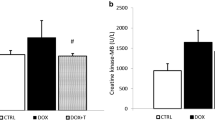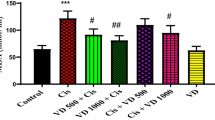Abstract
Although, the antiarrhythmic effect of amiodarone (AMD) is well characterized, the mechanism of its toxicity on extracardiac tissues is still poorly understood. Several antioxidants have been shown to prevent AMD-induced toxicity by antioxidant and/or non-antioxidant mechanisms. In the current study, we evaluated the possible protective effect, in vitro, of vitamin C on AMD-induced toxicity in rat thymocytes. Rat thymocytes were cultured with increasing AMD concentrations (1–20 μM) with or without vitamin C (1000 μg/ml), for 24 hours. Cells treatment with AMD resulted in a concentration-dependent increase of hypodiploid cells and a significant decrease in cellular glutathione content. Vitamin C combined with AMD significantly decreased the proportion of hypodiploid cells and markedly increased the cellular glutathione content, compared with AMD treatment alone. These results suggest that treatment with vitamin C may prevent AMD-induced toxicity in rat thymocytes by restoring cellular glutathione content.
Similar content being viewed by others
References
Kodama I, Kamiya K, Toyama J. (1999). Amiodarone: ionic and cellular mechanisms of action of the most promising class III agent. Am J Cardiol, 84, 20–8
Bargout R, Jankov A, Dincer E, Wang R, Komodromos T, Ibarra-Sunga, Filippatos G, Uhal BD. (2000). Amiodarone induces apoptosis of human and rat alveolar epithelial cells in vitro. Am J Physiol, 278, 1039–44
Jamshidzadeh A, Baghban M, Azarpira N, Bardbori AM, Niknahad H. (2008). Effects of tomato extract on oxidative stress induced toxicity in different organs of rats. Food Chem Toxicol, 46, 3612–15
Kaufmann P, Torok M, Hanni A, Roberts P, Gasser R, Krahenbuhl S. (2005). Mechanisms of benzarone and benzbromarone induced hepatic toxicity. Hepatology, 41, 925–35
Di Matola T, D’Ascoli F, Fenzi G, Rossi G, Martino E, Bogazzi F, Vitale M. (2000). Amiodarone induces cytochrome c release and apoptosis through an iodine-independent mechanism. J Clin Endocrinol Metab, 85, 4323–30
Isomoto S, Kawakami A, Arakaki T, Yamashita S, Yano K, Ono K. (2006). Effects of antiarrhythmic drugs on apoptotic pathways in H9c2 cardiac cells. J Pharmacol Sci, 101, 318–24
Varbiro G, Toth A, Tapodi A, Veres B, Sumegi B, Gallyas F. (2003). Concentration dependent mitochondrial effect of amiodarone. Biochem Pharmacol, 65, 1115–28
Enomoto R, Komai T, Yoshida Y, Sugahara C, Kawaguchi E, Okazaki K, Kinoshita H. Komatsu H, Konishi Y, Lee E. (2004). Terfenadine induces thymocyte apoptosis via mitochondrial pathway. Eur J Pharmacol, 496, 11–21
Piccotti JR, LaGattuta MS, Knight SA, Gonzales AJ, Bleavins MR. (2005). Induction of apoptosis by cationic amphiphilic drugs amiodarone and imipramine. Drug Chem Toxicol, 28, 117–33
Agoston M, Cabello RG, Blazovics A, Fehr J, Vereckei A. (2001). The effect of amiodarone and/or antioxidant treatment on splenocyte blast transformation. Clin Chim Acta, 303, 87–94
Ray SD, Patel D, Wong U, Bagchi D. (2000). In vivo protection of DNA damage associated apoptotic and necrotic cell deaths during acetaminophen-induced nephrotoxicity, amiodarone-induced lung toxicity and doxorubicin-induced cardiotoxicity by a novel IH 636 grape seed proanthocyanidin extract. Res Commun Mol Pathol Pharmacol, 107, 137–66
Agoston M, Orsi F, Feher E, Hagymasi K, Orosz Z, Blazovics A, Feher J, Vereckei A. (2003). Silymarin and vitamin E reduce amiodarone-induced lysosomal phospholipidosis in rats. Toxicology, 190, 231–41
Sarma JS, Pei H, Venkataraman K. (1997). Role of oxidative stress in amiodarone-induced toxicity. J Cardiovasc Pharmacol Ther, 2, 53–60
Bolt MW, Racz WJ, Brien JF, Massey TE. (2001). Effects of vitamin E on cytotoxicity of amiodarone and desethylamiodarone in isolated hamster lung cells. Toxicology, 166, 109–18
Massey TE, Leeder RG, Rafeiro E, Brien JF. (1995). Mechanisms in the pathogenesis of amiodarone-induced pulmonary toxicity. Can J Physiol Pharmacol, 73, 1675–85
Hartel C, Strunk T, Bucsky P, Schultz C. (2004). Effects of vitamin C on intracytoplasmic cytokine production in human whole blood monocytes and lymphocytes. Cytokine, 27, 101–6
Arrigoni O, De Tullio MC. (2002). Ascorbic acid: much more than just an antioxidant. Biochim Biophys Acta, 1569, 1–9
Campbell JD, Cole M, Bunditrutavorn B, Vella AT. (1999). Ascorbic acid is a potent inhibitor of various forms of T cell apoptosis. Cell Immunol, 194, 1–5
Wu CC, Doriarajan T, Lin TL. (2000). Effect of ascorbic acid supplementation on the immune response of chickens vaccinated and challenged with infectious bursal disease virus. Vet Immuno Immunopathol, 74, 145–52
Pavlovic V, Cekic S, Kocic G, Sokolovic D, Zivkovic V. (2007a). Effect of monosodium glutamate on apoptosis and Bcl-2/Bax protein level in rat thymocyte culture. Physiol Res, 56, 619–26
Nicoletti I, Migliorati G, Pagliacci MC, Grignani F, Riccardi C. (1991). A rapid and simple method for measuring thymocyte apoptosis by propidium iodide staining and flow cytometry. J Immunol Methods, 139, 271–9
Chikahisa L, Oyama Y, Okazaki E, Noda K. (1996). Fluorescent estimation of H2O2-induced changes in cell viability and cellular non-protein thiol level of dissociated rat thymocytes. Jpn J Pharmacol, 71, 299–305
Zhang N, Hartig H, Dzhagalov I, Draper D, He YW. (2005). The role of apoptosis in the development and function of T lymphocytes. Cell Res, 15, 749–69
Savino W, Dardenne M. (2000). Neuroendocrine control of thymus physiology. Endocr Rev, 21, 412–43
Robinson MK, Rodrick ML, Jacobs DO, Rounds JD, Collins KH, Saporoschetz IB, Mannick JA, Wilmore DW. (1993). Glutathione depletion in rats impairs T-cell and macrophage immune function. Arch Surg, 128, 29–34
Verma RS, Mehta A, Srivastava N. (2007). In vivo chlorpyrifos induced oxidative stres: attenuation by antioxidant vitamins. Pestic Biochem Phys, 88, 191–6
Meister A. (1994). Glutathione-ascorbic acid antioxidant system in animals. J Biol Chem, 269, 9397–400
Puskas F, Gergely P, Banki K, Perl A. (2000). Stimulation of the pentose phosphate pathway and glutathione levels by dehydroascorbate, the oxidized form of vitamin C. Faseb J, 14, 1352–61
Hildeman DA, Mitchell T, Aronow B, Wojciechowski S, Kappler J, Marrack P. (2003). Control of Bcl-2 expression by reactive oxygen species. Proc Natl Acad Sci, 100, 15035–40
Pavlovic V, Pavlovic D, Kocic G, Sokolovic D, Jevtovic-Stoimenov T, Cekic S, Velickovic D. (2007b). Effect of monosodium glutamate on oxidative stress and apoptosis in rat thymus. Mol Cell Biochem, 303, 161–6
Saitoh Y, Ouchida R, Kayasuga A, Miwa N. (2003). Anti-Apoptotic Defense of bcl-2 Gene Against Hydroperoxide-Induced Cytotoxicity Together With Suppressed Lipid Peroxidation, Enhanced Ascorbate Uptake, and Upregulated Bcl-2 Protein. J Cell Biochem, 89, 321–34
Pavlovic V, Pavlovic D, Kocic G, Sokolovic D, Sarac M, Jovic Z. (2009). Ascorbic acid modulates monosodium glutamate induced cytotoxicity in rat thymus. Bratisl Lek Listy, 110, 205–9
Prakova G, Gidikova P, Slavov E, Sandeva G, Stanilova S. (2009). Serum neopterin in workers exposed to inorganic dust containing free crystalline silicom dioxide. Cent Eur J Med, 4, 104–109
Babusyte A, Jeroch J, Stakauskas R, Salakuskas R. (2009). The production of reactive oxygen species in peripheral blood neutrophilis modulated by airway mucous. Cent Eur J Med, 4, 245–252
Cayir K, Kardeniz A, Yildirim A, Kalkan Y, Karakoc A, Keles M, Tekin SB. (2009). Protective effect of L-karnitine against cisplatin-induced liver and kidney oxidant injury in rats. Cent Eur J Med, 4, 184–191
Author information
Authors and Affiliations
Corresponding author
About this article
Cite this article
Cekic, S., Pavlovic, D., Sarac, M. et al. The effect of vitamin C on amiodarone-induced toxicity in rat thymocytes. cent.eur.j.med 6, 58–63 (2011). https://doi.org/10.2478/s11536-010-0050-5
Received:
Accepted:
Published:
Issue Date:
DOI: https://doi.org/10.2478/s11536-010-0050-5




